YAMAHA TTR50 2013 Repair Manual
Manufacturer: YAMAHA, Model Year: 2013, Model line: TTR50, Model: YAMAHA TTR50 2013Pages: 86, PDF Size: 1.8 MB
Page 61 of 86
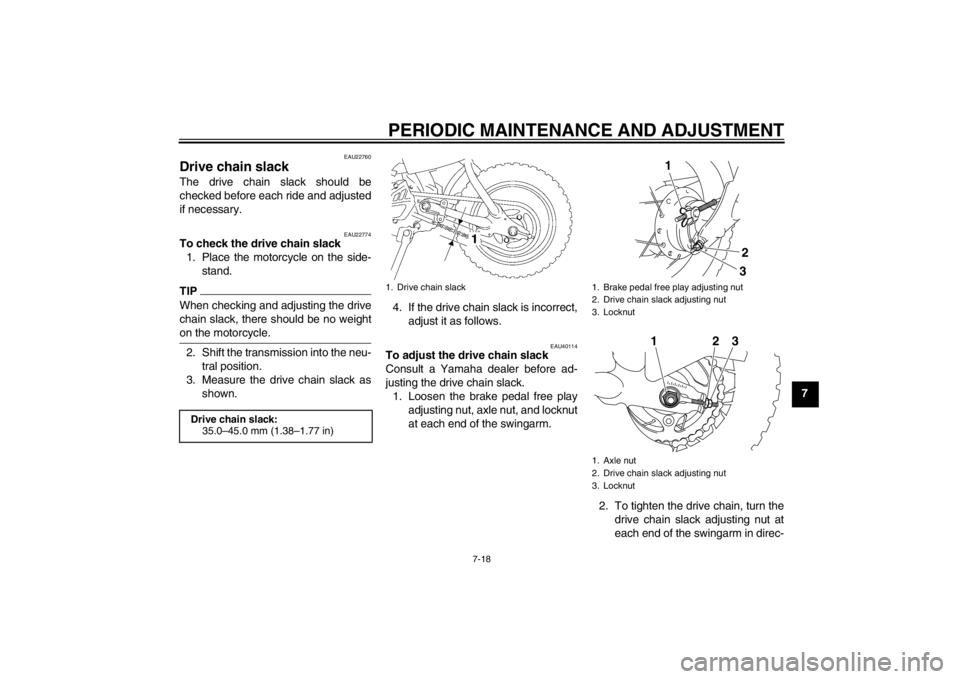
PERIODIC MAINTENANCE AND ADJUSTMENT
7-18
7
EAU22760
Drive chain slack The drive chain slack should be
checked before each ride and adjusted
if necessary.
EAU22774
To check the drive chain slack1. Place the motorcycle on the side- stand.TIPWhen checking and adjusting the drive
chain slack, there should be no weight
on the motorcycle.2. Shift the transmission into the neu- tral position.
3. Measure the drive chain slack as shown. 4. If the drive chain slack is incorrect,
adjust it as follows.
EAU40114
To adjust the drive chain slack
Consult a Yamaha dealer before ad-
justing the drive chain slack.1. Loosen the brake pedal free play adjusting nut, axle nut, and locknut
at each end of the swingarm.
2. To tighten the drive chain, turn thedrive chain slack adjusting nut at
each end of the swingarm in direc-
Drive chain slack:35.0–45.0 mm (1.38–1.77 in)
1. Drive chain slack
1. Brake pedal free play adjusting nut
2. Drive chain slack adjusting nut
3. Locknut
1. Axle nut
2. Drive chain slack adjusting nut
3. Locknut
1
2
3
2
3
1
U2CJ80E0.book Page 18 Tuesday, June 12, 2012 11:15 AM
Page 62 of 86
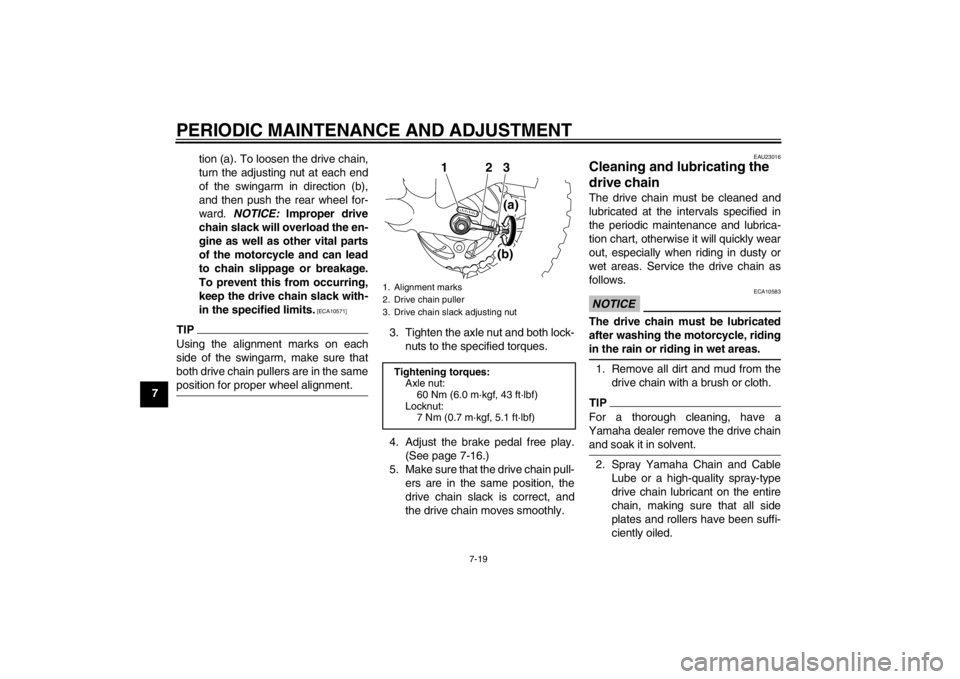
PERIODIC MAINTENANCE AND ADJUSTMENT
7-19
7tion (a). To loosen the drive chain,
turn the adjusting nut at each end
of the swingarm in direction (b),
and then push the rear wheel for-
ward.
NOTICE: Improper drive
chain slack will overload the en-
gine as well as other vital parts
of the motorcycle and can lead
to chain slippage or breakage.
To prevent this from occurring,
keep the drive chain slack with-
in the specified limits.
[ECA10571]
TIPUsing the alignment marks on each
side of the swingarm, make sure that
both drive chain pullers are in the same
position for proper wheel alignment.
3. Tighten the axle nut and both lock- nuts to the specified torques.
4. Adjust the brake pedal free play. (See page 7-16.)
5. Make sure that the drive chain pull- ers are in the same position, the
drive chain slack is correct, and
the drive chain moves smoothly.
EAU23016
Cleaning and lubricating the
drive chain The drive chain must be cleaned and
lubricated at the intervals specified in
the periodic maintenance and lubrica-
tion chart, otherwise it will quickly wear
out, especially when riding in dusty or
wet areas. Service the drive chain as
follows.NOTICE
ECA10583
The drive chain must be lubricated
after washing the motorcycle, riding
in the rain or riding in wet areas.1. Remove all dirt and mud from thedrive chain with a brush or cloth.TIPFor a thorough cleaning, have a
Yamaha dealer remove the drive chain and soak it in solvent.2. Spray Yamaha Chain and Cable Lube or a high-quality spray-type
drive chain lubricant on the entire
chain, making sure that all side
plates and rollers have been suffi-
ciently oiled.
1. Alignment marks
2. Drive chain puller
3. Drive chain slack adjusting nutTightening torques:Axle nut:
60 Nm (6.0 m·kgf, 43 ft·lbf)
Locknut: 7 Nm (0.7 m·kgf, 5.1 ft·lbf)
(b)(a)3
2
1
U2CJ80E0.book Page 19 Tuesday, June 12, 2012 11:15 AM
Page 63 of 86
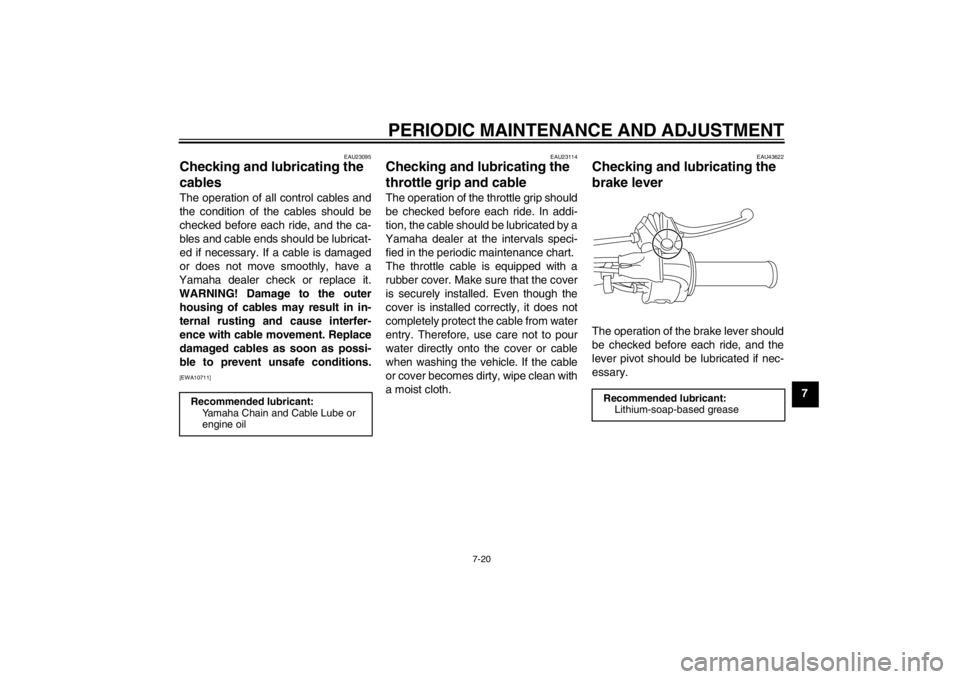
PERIODIC MAINTENANCE AND ADJUSTMENT
7-20
7
EAU23095
Checking and lubricating the
cables The operation of all control cables and
the condition of the cables should be
checked before each ride, and the ca-
bles and cable ends should be lubricat-
ed if necessary. If a cable is damaged
or does not move smoothly, have a
Yamaha dealer check or replace it.
WARNING! Damage to the outer housing of cables may result in in-
ternal rusting and cause interfer-
ence with cable movement. Replace
damaged cables as soon as possi-
ble to prevent unsafe conditions.[EWA10711] EAU23114
Checking and lubricating the
throttle grip and cable The operation of the throttle grip should
be checked before each ride. In addi-
tion, the cable should be lubricated by a
Yamaha dealer at the intervals speci-
fied in the periodic maintenance chart.
The throttle cable is equipped with a
rubber cover. Make sure that the cover
is securely installed. Even though the
cover is installed correctly, it does not
completely protect the cable from water
entry. Therefore, use care not to pour
water directly onto the cover or cable
when washing the vehicle. If the cable
or cover becomes dirty, wipe clean with
a moist cloth.
EAU43622
Checking and lubricating the
brake lever The operation of the brake lever should
be checked before each ride, and the
lever pivot should be lubricated if nec-
essary.
Recommended lubricant:
Yamaha Chain and Cable Lube or
engine oil
Recommended lubricant:Lithium-soap-based grease
U2CJ80E0.book Page 20 Tuesday, June 12, 2012 11:15 AM
Page 64 of 86
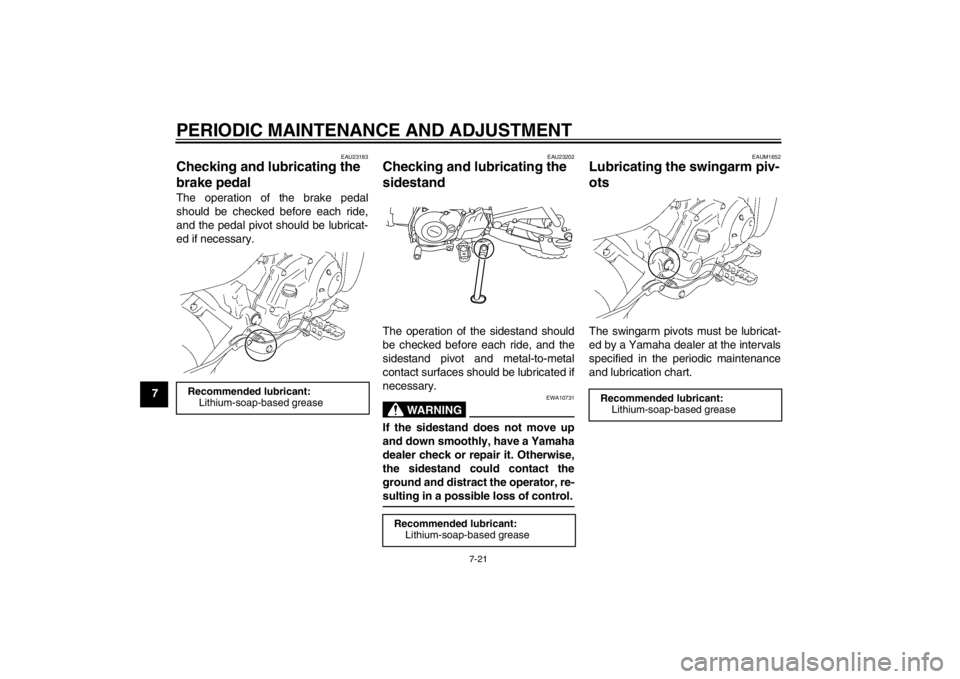
PERIODIC MAINTENANCE AND ADJUSTMENT
7-21
7
EAU23183
Checking and lubricating the
brake pedal The operation of the brake pedal
should be checked before each ride,
and the pedal pivot should be lubricat-
ed if necessary.
EAU23202
Checking and lubricating the
sidestand The operation of the sidestand should
be checked before each ride, and the
sidestand pivot and metal-to-metal
contact surfaces should be lubricated if
necessary.
WARNING
EWA10731
If the sidestand does not move up
and down smoothly, have a Yamaha
dealer check or repair it. Otherwise,
the sidestand could contact the
ground and distract the operator, re-
sulting in a possible loss of control.
EAUM1652
Lubricating the swingarm piv-
ots The swingarm pivots must be lubricat-
ed by a Yamaha dealer at the intervals
specified in the periodic maintenance
and lubrication chart.
Recommended lubricant:Lithium-soap-based grease
Recommended lubricant:Lithium-soap-based grease
Recommended lubricant:Lithium-soap-based grease
U2CJ80E0.book Page 21 Tuesday, June 12, 2012 11:15 AM
Page 65 of 86
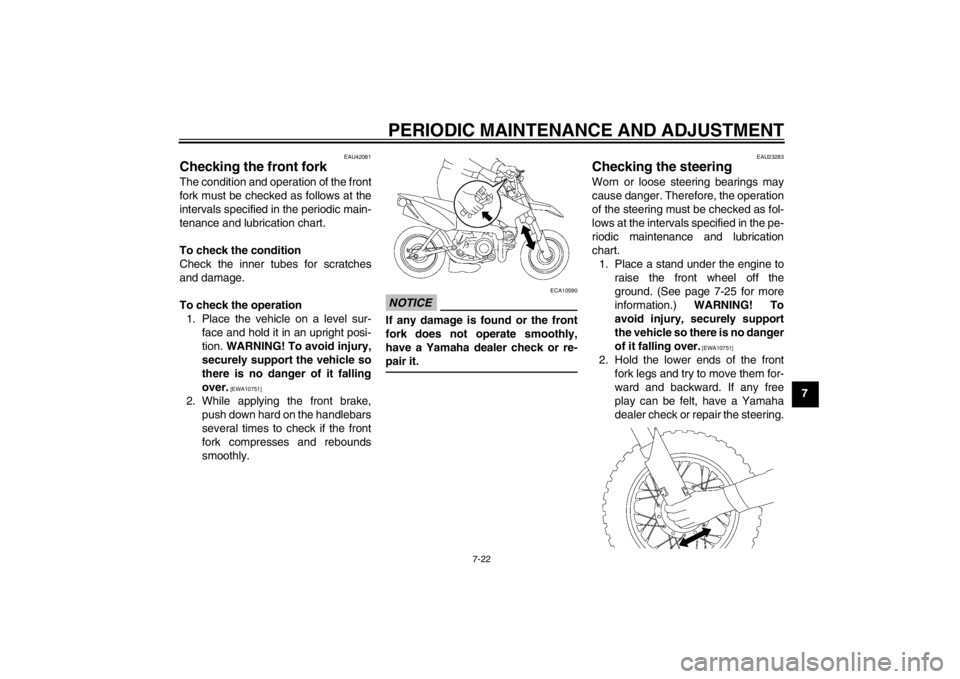
PERIODIC MAINTENANCE AND ADJUSTMENT
7-22
7
EAU42081
Checking the front fork The condition and operation of the front
fork must be checked as follows at the
intervals specified in the periodic main-
tenance and lubrication chart.
To check the condition
Check the inner tubes for scratches
and damage.
To check the operation1. Place the vehicle on a level sur- face and hold it in an upright posi-
tion. WARNING! To avoid injury,
securely support the vehicle so
there is no danger of it falling
over.
[EWA10751]
2. While applying the front brake, push down hard on the handlebars
several times to check if the front
fork compresses and rebounds
smoothly.
NOTICE
ECA10590
If any damage is found or the front
fork does not operate smoothly,
have a Yamaha dealer check or re-
pair it.
EAU23283
Checking the steering Worn or loose steering bearings may
cause danger. Therefore, the operation
of the steering must be checked as fol-
lows at the intervals specified in the pe-
riodic maintenance and lubrication
chart.1. Place a stand under the engine to raise the front wheel off the
ground. (See page 7-25 for more
information.) WARNING! To
avoid injury, securely support
the vehicle so there is no danger
of it falling over.
[EWA10751]
2. Hold the lower ends of the front fork legs and try to move them for-
ward and backward. If any free
play can be felt, have a Yamaha
dealer check or repair the steering.
U2CJ80E0.book Page 22 Tuesday, June 12, 2012 11:15 AM
Page 66 of 86

PERIODIC MAINTENANCE AND ADJUSTMENT
7-23
7
EAU23291
Checking the wheel bearings The front and rear wheel bearings must
be checked at the intervals specified in
the periodic maintenance and lubrica-
tion chart. If there is play in the wheel
hub or if the wheel does not turn
smoothly, have a Yamaha dealer check
the wheel bearings.
EAU40446
Battery The battery is located under the seat.
(See page 4-8.)
This model is equipped with a VRLA
(Valve Regulated Lead Acid) battery.
There is no need to check the electro-
lyte or to add distilled water. However,
the battery coupler connection needs to
be checked to make sure that it is se-
curely connected.
WARNING
EWA10760
●
Electrolyte is poisonous and
dangerous since it contains sul-
furic acid, which causes severe
burns. Avoid any contact withskin, eyes or clothing and al-
ways shield your eyes when
working near batteries. In case
of contact, administer the fol-
lowing FIRST AID.
EXTERNAL: Flush with plenty of water.
INTERNAL: Drink large quan- tities of water or milk and im-
mediately call a physician.
EYES: Flush with water for 15 minutes and seek prompt
medical attention.
●
Batteries produce explosive hy-
drogen gas. Therefore, keep
sparks, flames, cigarettes, etc.,
away from the battery and pro-
vide sufficient ventilation when
charging it in an enclosed
space.
●
KEEP THIS AND ALL BATTER-
IES OUT OF THE REACH OF
CHILDREN.
To charge the battery
Have a Yamaha dealer charge the bat-
tery as soon as possible if it seems to
have discharged. Keep in mind that the
1. Battery
2. Battery coupler
1
2
U2CJ80E0.book Page 23 Tuesday, June 12, 2012 11:15 AM
Page 67 of 86

PERIODIC MAINTENANCE AND ADJUSTMENT
7-24
7
battery tends to discharge more quickly
if the vehicle is equipped with optional
electrical accessories.
NOTICE
ECA16521
To charge a VRLA (Valve Regulated
Lead Acid) battery, a special (con-
stant-voltage) battery charger is re-
quired. Using a conventional battery
charger will damage the battery.To store the battery
1. If the vehicle will not be used for more than one month, remove the
battery, fully charge it, and then
place it in a cool, dry place.
NOTICE: When removing the
battery, be sure the key is
turned to “OFF” before discon-
necting the coupler.
[ECA16322]
2. If the battery will be stored for more than two months, check it at least
once a month and fully charge it if
necessary.
3. Fully charge the battery before in- stallation. NOTICE: When install-
ing the battery, be sure the key
is turned to “OFF” before con-
necting the coupler.
[ECA16930]
NOTICE
ECA16530
Always keep the battery charged.
Storing a discharged battery can
cause permanent battery damage.
EAU42024
Replacing the fuse The fuse is located inside the battery
coupler.
If the fuse is blown, replace it as fol-
lows. 1. Turn the key to “OFF” and turn off all electrical circuits.
2. Remove the seat. (See page 4-8.)
3. Remove the battery cover by re- moving the bolts.1. Battery coupler
2. Spare fuse
3. Fuse
32
1
U2CJ80E0.book Page 24 Tuesday, June 12, 2012 11:15 AM
Page 68 of 86
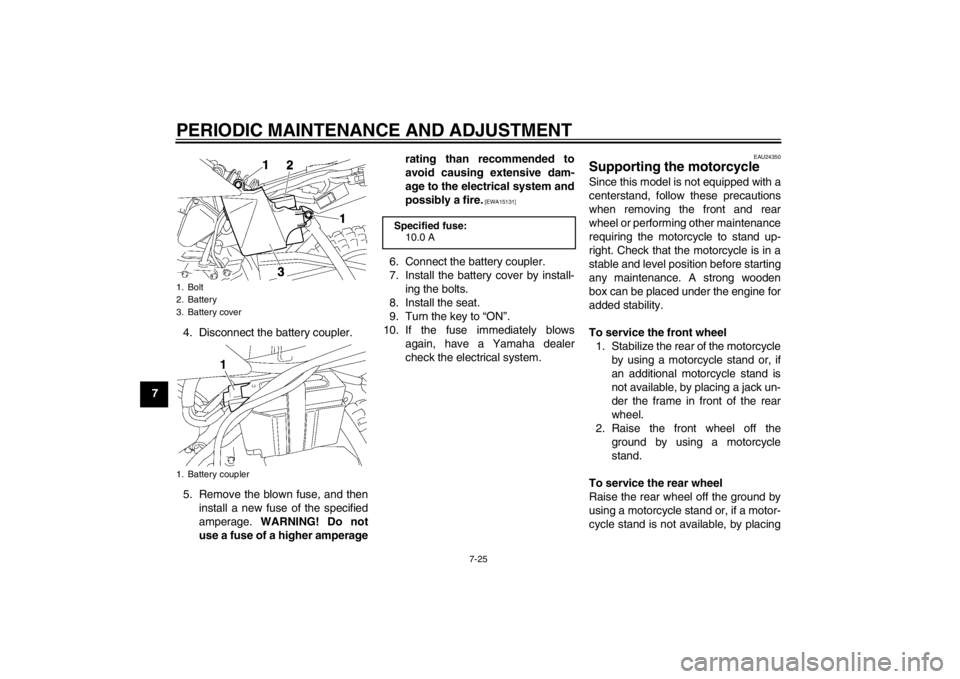
PERIODIC MAINTENANCE AND ADJUSTMENT
7-25
74. Disconnect the battery coupler.
5. Remove the blown fuse, and then
install a new fuse of the specified
amperage. WARNING! Do not
use a fuse of a higher amperage rating than recommended to
avoid causing extensive dam-
age to the electrical system and
possibly a fire.
[EWA15131]
6. Connect the battery coupler.
7. Install the battery cover by install-
ing the bolts.
8. Install the seat.
9. Turn the key to “ON”.
10. If the fuse immediately blows again, have a Yamaha dealer
check the electrical system.
EAU24350
Supporting the motorcycle Since this model is not equipped with a
centerstand, follow these precautions
when removing the front and rear
wheel or performing other maintenance
requiring the motorcycle to stand up-
right. Check that the motorcycle is in a
stable and level position before starting
any maintenance. A strong wooden
box can be placed under the engine for
added stability.
To service the front wheel1. Stabilize the rear of the motorcycle by using a motorcycle stand or, if
an additional motorcycle stand is
not available, by placing a jack un-
der the frame in front of the rear
wheel.
2. Raise the front wheel off the ground by using a motorcycle
stand.
To service the rear wheel
Raise the rear wheel off the ground by
using a motorcycle stand or, if a motor-
cycle stand is not available, by placing
1. Bolt
2. Battery
3. Battery cover
1. Battery coupler
1
Specified fuse: 10.0 A
U2CJ80E0.book Page 25 Tuesday, June 12, 2012 11:15 AM
Page 69 of 86
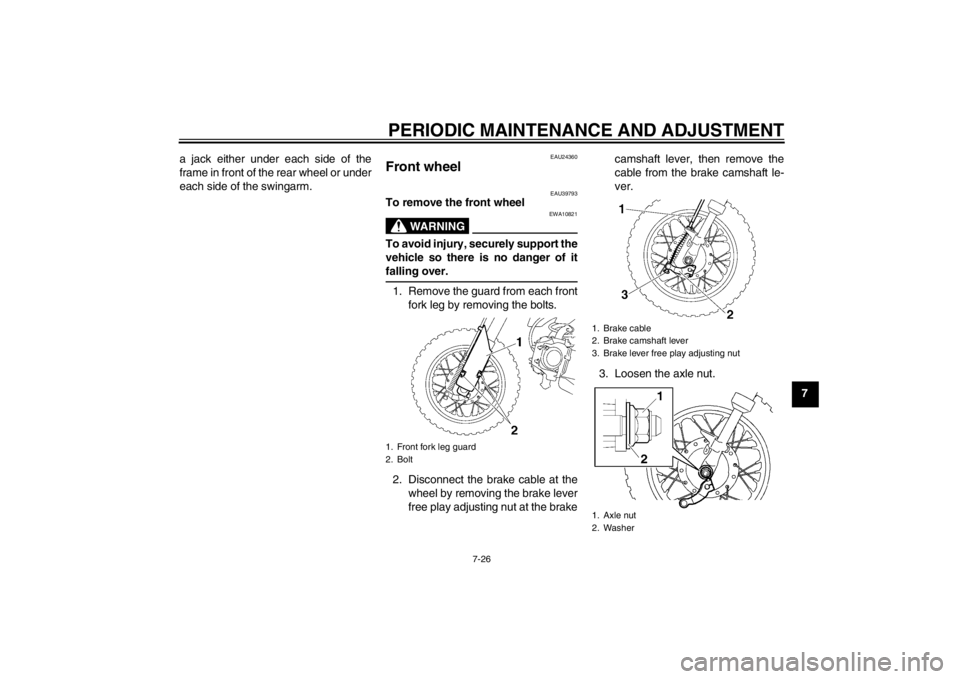
PERIODIC MAINTENANCE AND ADJUSTMENT
7-26
7
a jack either under each side of the
frame in front of the rear wheel or under
each side of the swingarm.
EAU24360
Front wheel
EAU39793
To remove the front wheel
WARNING
EWA10821
To avoid injury, securely support the
vehicle so there is no danger of it
falling over.1. Remove the guard from each front
fork leg by removing the bolts.
2. Disconnect the brake cable at the wheel by removing the brake lever
free play adjusting nut at the brake camshaft lever, then remove the
cable from the brake camshaft le-
ver.
3. Loosen the axle nut.1. Front fork leg guard
2. Bolt
1. Brake cable
2. Brake camshaft lever
3. Brake lever free play adjusting nut
1. Axle nut
2. Washer
U2CJ80E0.book Page 26 Tuesday, June 12, 2012 11:15 AM
Page 70 of 86
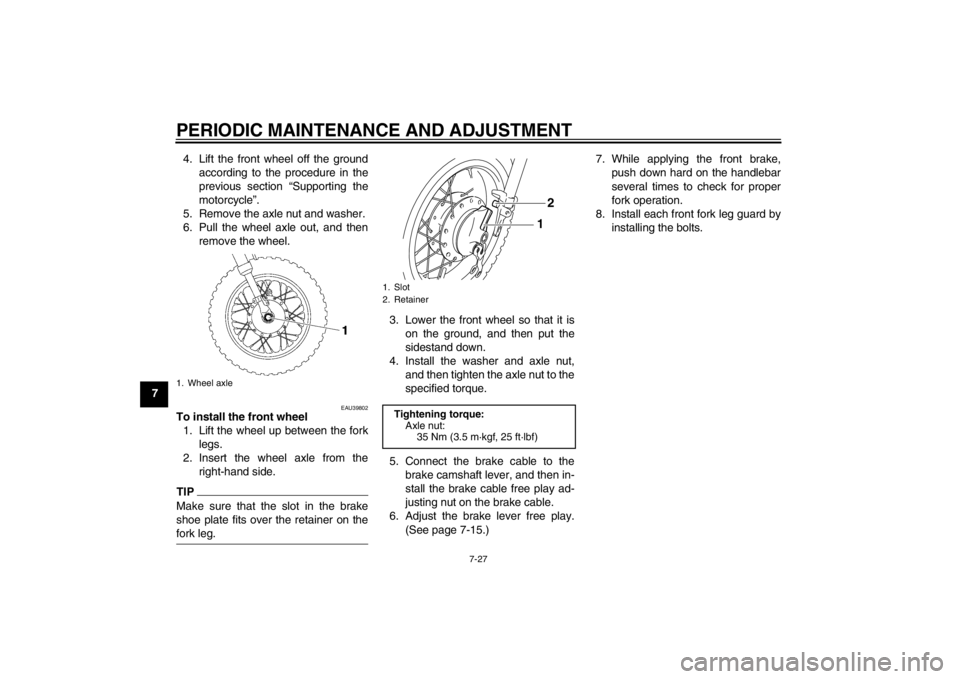
PERIODIC MAINTENANCE AND ADJUSTMENT
7-27
74. Lift the front wheel off the ground
according to the procedure in the
previous section “Supporting the
motorcycle”.
5. Remove the axle nut and washer.
6. Pull the wheel axle out, and then remove the wheel.
EAU39802
To install the front wheel1. Lift the wheel up between the fork legs.
2. Insert the wheel axle from the right-hand side.TIPMake sure that the slot in the brake
shoe plate fits over the retainer on the
fork leg.
3. Lower the front wheel so that it ison the ground, and then put the
sidestand down.
4. Install the washer and axle nut, and then tighten the axle nut to the
specified torque.
5. Connect the brake cable to the brake camshaft lever, and then in-
stall the brake cable free play ad-
justing nut on the brake cable.
6. Adjust the brake lever free play. (See page 7-15.) 7. While applying the front brake,
push down hard on the handlebar
several times to check for proper
fork operation.
8. Install each front fork leg guard by installing the bolts.
1. Wheel axle
1. Slot
2. RetainerTightening torque:Axle nut:35 Nm (3.5 m·kgf, 25 ft·lbf)
2
1
U2CJ80E0.book Page 27 Tuesday, June 12, 2012 11:15 AM